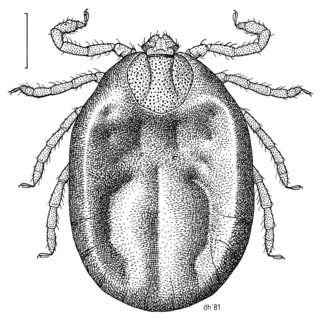
The Ixodidae are the family of hard ticks or scale ticks, one of the three families of ticks, consisting of over 700 species. They are known as 'hard ticks' because they have a scutum or hard shield, which the other major family of ticks, the 'soft ticks' (Argasidae), lack. They are ectoparasites of a wide range of host species, and some are vectors of pathogens that can cause human disease.

Haemaphysalis longicornis, the Asian longhorned tick, longhorned tick, bush tick, Asian tick, or cattle tick, is a parasitic arachnid belonging to the tick family Ixodidae. The Asian longhorned tick is a known livestock pest, especially in New Zealand, and can transmit a disease called theileriosis to cattle but not to humans. However, the tick has been associated with several other tickborne diseases in humans.

Haemaphysalis leporispalustris, the rabbit tick, is a species of tick that is widely distributed in the Americas, stretching from Alaska to Argentina. H. leporispalustris is known to have one of the largest distributions for a tick originating in the New World. It is a three-host tick and a member of the family Ixodidae, commonly called the "hard ticks," and the genus Haemaphysalis. Its common hosts are rabbits, hares, and sometimes ground-feeding birds. H. leporispalustris has a rigid scutum and a prominent capitulum projecting forward from its body and is often said to look like the "wood tick". It has a hemimetabolic life cycle. H. leporispalustris does not play a prominent role in disease transmission in humans but is a vector for disease in other animals.
The Bhanja virus is a tick-borne virus first discovered in a tick taken from a paralyzed goat in Bhanjanagar, India in 1954. Bhanja virus in humans was first documented in 1974 when Charles Calisher was working with the virus in a lab and contracted it himself. His experience with the virus was mild and included symptoms of mild aching in muscles and joints, moderate headache, slight photophobia. The Bhanja virus is a member of the Bhanja virus serocomplex and is a member of the Bunyavirales order.
The Asian tortoise tick, is a hard-bodied tick of the genus Amblyomma. The tick is a parasite of tortoises, such as Geochelone elegans, domestic dogs, buffaloes. It is found in India, Sri Lanka and Myanmar. Adult tick is about 3 cm in length.
Ixodes petauristae is a hard-bodied tick of the genus Ixodes. It is found in India and Sri Lanka. Adults parasitize various smaller mammals such as Ratufa indica, Funambulus tristriatus, Macaca radiata, Petaurista sp. and mice. It is a potential vector of Kyasanur Forest disease virus,
Haemaphysalis aculeata is a hard-bodied tick of the genus Haemaphysalis. It is found in India and Sri Lanka.
Haemaphysalis bispinosa is a hard-bodied tick of the genus Haemaphysalis. It is found in India, Sri Lanka, Myanmar, Pakistan, Nepal, Australia, and Indonesia. It is an obligate ectoparasite of mammals. It is a potential vector of Kyasanur Forest disease virus. These ticks was found parasitized by a chalcid Hunterellus sagarensis in these diseased areas.
Haemaphysalis anomala is a hard-bodied tick of the family Ixodidae. It is found in India, Vietnam and Sri Lanka. It is an obligate ectoparasite of mammals.
Haemaphysalis cuspidata is a hard-bodied tick of the genus Haemaphysalis. It is found in India and Sri Lanka. It is a potential vector of Kyasanur Forest disease virus.
Haemaphysalis hystricis, the East Asian mountain haemaphysalid, is a hard-bodied tick of the genus Haemaphysalis. It is found in India, Sri Lanka, Vietnam, Myanmar, China, Japan, India, Indonesia, Laos, Taiwan and Thailand. It is an obligate ectoparasite of mammals. It is a potential vector of Kyasanur Forest disease virus, Coxiella sp., Ehrlichia sp., and Rickettsia japonica. In 2007, an unknown trypanosoma species known as Trypanosoma KG1 isolate was isolated from naturally infected H. hystricis ticks.
Haemaphysalis intermedia, the flat-inner-spurred haemaphysalid, is a hard-bodied tick of the genus Haemaphysalis. It is found in India and Sri Lanka. It is an obligate ectoparasite of mammals. It is a potential vector of Kyasanur Forest disease virus, Ganjam virus, and Nairobi sheep disease virus.

Haemaphysalis leachi, the yellow dog tick, is a hard-bodied tick of the genus Haemaphysalis. It is also known as African dog tick, or simply as dog tick in many parts of the world.
Haemaphysalis minuta, is a hard-bodied tick of the genus Haemaphysalis. It is found in India and Sri Lanka. It is an obligate ectoparasite of mammals. It is a potential vector of Kyasanur Forest disease virus.
Haemaphysalis spinigera, is a hard-bodied tick of the genus Haemaphysalis. It is found in India, Sri Lanka, Vietnam. It is an obligate ectoparasite of mammals of various rodents, insectivores and monkeys. It is a potential vector of Kyasanur Forest disease virus, and Kaisodi virus.
Haemaphysalis turturis is a hard-bodied tick of the family Ixodidae. It is found in India and Sri Lanka. It is an obligate ectoparasite of mammals. It is a potential vector of Kyasanur Forest disease virus, and ganjam virus.
Hyalomma brevipunctata, or Sharif's Indian hyalomma, is a hard-bodied tick of the family Ixodidae. It is found in India and Sri Lanka.
Nosomma monstrosum, is a hard-bodied tick of the genus Nosomma. It is found in India, Bangladesh, Sri Lanka and Vietnam.

The Cattle tick,, is a hard-bodied tick of the genus Rhipicephalus. It is also known as North American cattle tick, North American Texas fever tick, and Texas fever tick.




